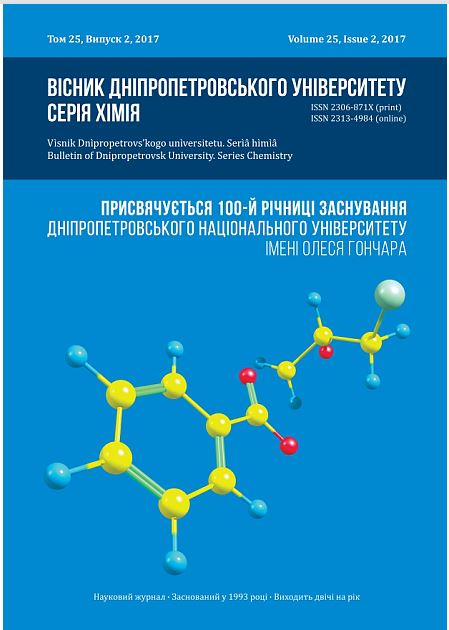Моделювання поведінки бензоатів тетраалкіламонію в реакції розкриття оксиранового циклу 2-(хлорметил)оксирану карбоновими кислотами
DOI:
https://doi.org/10.15421/081710Keywords:
2-(хлорметил)оксиран, бензоат-аніон, бензойна кислота, перехідний станAbstract
Досліджено методами квантової хімії регіоселективність реакції розкриття оксиранового циклу бензоат-аніоном в системі «2-(хлорметил)оксиран – бензойна кислота – бензоат тетраалкіламонію». Знайдено рівноважні конфігурації можливих перехідних станів на шляху реакції у випадку тилової та фронтальної атаки нуклеофілом на первинний та вторинний атоми Карбону 2-(хлорметил)оксирану у Z- та Е-конфігураціях. Оцінено геометричні та активаційні параметри можливих перехідних станів на шляху реакції. За величинами ступеню розриву / утворення зв'язку показано, що знайдені перехідні стани відносяться до дисоціативних. За допомогою двохвимірного варіанта діаграми Мор О'Ферелла-Дженкса проаналізовані можливі шляхи здійснення реакції за механізмами нуклеофільного заміщення (SN2, SN1, «граничний» SN2). Зроблено висновки щодо механізму реакції розриття оксиранового циклу та стерео- і регіоселективності реакції. Встановлено, що використання бензоат-аніона як нуклеофіла сприяє збільшенню внеска SN2 механізма та зменшенню внеска «граничного» SN2 механізма, що приводить до підвищення стерео- та регіоселективності реакції. Найбільш сприятливою є тилова атака бензоат-аніоном (SN2 механізм), яка сприяє більш високій стереоселективності реакції з утворенням хлоргідринового ефіру з оберненою конфігурацією, чому додатково сприяє Е-конфігурація нуклеофіла та хлорметильної групи в перехідному стані.
References
Bukowski A. Hydroxy functionalozed porous polymer particles derived from mixtures of hydrophilic and hydrophobic monomers / A. Bukowski, W. Bukowski, S. Kleczynska et al. // Polimery. – 2016. ― V. 61. ― P. 616―624. DOI: 10.14314/polimery.2016.616
Бобылев В.А. Специальные эпоксидные смолы для клеев и герметиков / В.А. Бобылев // Клеи. Герметики. Технологии. ― 2005. ― № 5. ― С. 8-11.
Epihalohydrins in Organic Synthesis / G.S. Singh, K. Mollet, M. D’hooghe, N. De Kimpe // Chem. Rev., 2013. ― Vol. 113, № 3. ― Р. 1441-1498. DOI: 10.1021/cr3003455
Lau E.Y. A theoretical of acid-catalyzed and noncatalyzed ring-opening reaction of an oxirane by nucleophilic addition of acetate. Implications to epoxide hydrolase / E.Y. Lau, Z.E. Newby, Th.C. Bruice // J. Am. Chem. Soc. ― 2001. ― № 14. ― Р. 3350-3375. DOI: 10.1021/ja0037724
Алициклические эпоксидные соединения. Реакционная способность / Л.И. Касьян, А.О. Касьян, С.И. Оковитый, И.Н. Тарабара. ― Днепропетровск: Изд-во Днепропетр. Ун-та, 2003. ― 516 с.
Получение хлоргидриновых эфиров карбоновых кислот / М.Ф. Сорокин. Л. Г. Шодэ, А.И. Кузьмин и др. // Лакокрасочные материалы и их применение. ― 1983. ― № 4. ― С. 4-7.
Sinel’nikova M. A. Regioselectivity of the Acidolysis of 2-(Chloromethyl) oxirane with Aromatic Acids in the Presence of Organic Bases / M. A. Sinel’nikova, E. N. Shved // Russian Journal of General Chemistry, 2014, Vol. 50, No. 3, pp. 332–336 DOI: 10.1134/S107042801403004X
Швец В.Ф. Кинетика и стереохимия реакции -окисей с уксусной кислотой при катализе третичными аминами / В.Ф. Швец, О.А. Тюкова // Журнал органической химии. ― 1971. ― № 9. ― С. 1847-1850.
Pal N. Kinetics and mechanism of esterification of monoepoxies / N. Pal, A. Srivastava, S. Agrawal, J.S.P. Rai // Matirials and Manufacturing Processes. ― 2005. ― Vol. 20. ―. P. 317-327. DOI: 10.1081/AMP-200042132
Bakhtin S. Nucleophile‐electrophile interactions in the reaction of oxiranes with carboxylic acids in the presence of tertiary amines / S. Bakhtin, E. Shved, Y. Bespal'ko // J. Phys. Org. Chem. ― 2017. ― Vol. 30, № 6. ― P. 3717-3725. DOI: 10.1002/poc.3717
Новаковская Ю.В. Определение термодинамичеcких характеристик и кинетичеcких характеристик элементарных реакций на основании квантовохимических расчетов / Ю.В. Новаковская. ― М., 2010. ― 59 с.
Quantum-Chemical Investigation of Epoxidic Compounds Transformation. Application for In Vitro and In Vivo Processes Modeling (Chapter 10). Book chapter in Application of Computational Techniques in Pharmacy and Medicine, Challenges and Advances in Computational Chemistry and Physics Eds: L. Gorb, V. Kuz’min, E. Muratov // Springer Science. ― 2014. ― Vol. 17. ― P. 295-323. DOI: 10.1007/978-94-017-9257-8_10
Alex A. Granovsky, Firefly version 7.1.G, www http://classic.chem.msu.su/gran/firefly/index.htm
Grigoriy A. Zhurko, СhemCraftLite, http://www.chemcraftprog.com/index.html
Scott A.P. Harmonic vibrational frequencies: an evaluation of hartree-fock, møller-plesset, quadratic configuration interaction, density functional theory, and semiempirical scale factors / A.P. Scott, L. Radom Harmonic // J. Phys. Chem. ― 1996. ― № 100. ―Р. 16502-16513. DOI: S0022-3654(96)00976-8
Bouteiller Y. Transferable specific scaling factors for interpretation of infrared spectra of biomolecules from density functional theory / Y. Bouteiller, J.-C. Gillet, G. Gre’goire, J.P Schermann // J. Phys. Chem. A. ― 2008. ― № 112. ― P. 11656-11660. DOI: 10.1021/jp805854q
Downloads
Published
Issue
Section
License
Copyright (c) 2018 Дніпропетровський національний університет імені Олеся Гончара

This work is licensed under a Creative Commons Attribution 4.0 International License.
- Authors reserve the right of attribution for the submitted manuscript, while transferring to the Journal the right to publish the article under the Creative Commons Attribution License. This license allows free distribution of the published work under the condition of proper attribution of the original authors and the initial publication source (i.e. the Journal)
- Authors have the right to enter into separate agreements for additional non-exclusive distribution of the work in the form it was published in the Journal (such as publishing the article on the institutional website or as a part of a monograph), provided the original publication in this Journal is properly referenced
- The Journal allows and encourages online publication of the manuscripts (such as on personal web pages), even when such a manuscript is still under editorial consideration, since it allows for a productive scientific discussion and better citation dynamics (see The Effect of Open Access).


